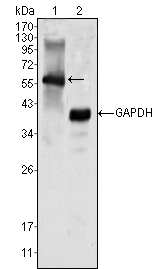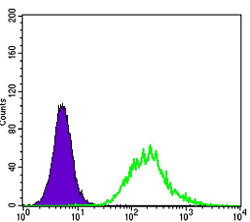Lsk Monoclonal Antibody
- Catalog No.:YM0423
- Applications:WB;FCM;ELISA
- Reactivity:Human
- Target:
- Lsk
- Fields:
- >>Neurotrophin signaling pathway
- Gene Name:
- MATK
- Protein Name:
- Megakaryocyte-associated tyrosine-protein kinase
- Human Gene Id:
- 4145
- Human Swiss Prot No:
- P42679
- Mouse Swiss Prot No:
- P41242
- Immunogen:
- Purified recombinant fragment of human Lsk expressed in E. Coli.
- Specificity:
- Lsk Monoclonal Antibody detects endogenous levels of Lsk protein.
- Formulation:
- Liquid in PBS containing 50% glycerol, 0.5% BSA and 0.02% sodium azide.
- Source:
- Monoclonal, Mouse
- Dilution:
- WB 1:500 - 1:2000. Flow cytometry: 1:200 - 1:400. ELISA: 1:10000. Not yet tested in other applications.
- Purification:
- Affinity purification
- Concentration:
- 1 mg/ml
- Storage Stability:
- -15°C to -25°C/1 year(Do not lower than -25°C)
- Other Name:
- MATK;CTK;HYL;Megakaryocyte-associated tyrosine-protein kinase;CSK homologous kinase;CHK;Hematopoietic consensus tyrosine-lacking kinase;Protein kinase HYL;Tyrosine-protein kinase CTK
- Molecular Weight(Da):
- 56kD
- References:
- 1. Int J Oncol. 2002 Jul;21(1):197-205.
2. Proc Natl Acad Sci U S A. 2002 Dec 24;99(26):16899-903.
3. Nat Genet. 2004 Jan;36(1):40-5.
- Background:
- The protein encoded by this gene has amino acid sequence similarity to Csk tyrosine kinase and has the structural features of the CSK subfamily: SRC homology SH2 and SH3 domains, a catalytic domain, a unique N terminus, lack of myristylation signals, lack of a negative regulatory phosphorylation site, and lack of an autophosphorylation site. This protein is thought to play a significant role in the signal transduction of hematopoietic cells. It is able to phosphorylate and inactivate Src family kinases, and may play an inhibitory role in the control of T-cell proliferation. This protein might be involved in signaling in some cases of breast cancer. Three alternatively spliced transcript variants that encode different isoforms have been described for this gene. [provided by RefSeq, Jul 2008],
- Function:
- catalytic activity:ATP + a [protein]-L-tyrosine = ADP + a [protein]-L-tyrosine phosphate.,function:Could play a significant role in the signal transduction of hematopoietic cells. May regulate tyrosine kinase activity of SRC-family members in brain by specifically phosphorylating their C-terminal regulatory tyrosine residue which acts as a negative regulatory site. It may play an inhibitory role in the control of T-cell proliferation.,PTM:Phosphorylated upon DNA damage, probably by ATM or ATR.,similarity:Belongs to the protein kinase superfamily. Tyr protein kinase family.,similarity:Belongs to the protein kinase superfamily. Tyr protein kinase family. CSK subfamily.,similarity:Contains 1 protein kinase domain.,similarity:Contains 1 SH2 domain.,similarity:Contains 1 SH3 domain.,tissue specificity:Expressed in various myeloid cell lines, detected in brain and lung.,
- Subcellular Location:
- Cytoplasm . Membrane . In platelets, 90% of MATK localizes to the membrane fraction, and translocates to the cytoskeleton upon thrombin stimulation.
- Expression:
- Expressed in various myeloid cell lines, detected in brain and lung.
- June 19-2018
- WESTERN IMMUNOBLOTTING PROTOCOL
- June 19-2018
- IMMUNOHISTOCHEMISTRY-PARAFFIN PROTOCOL
- June 19-2018
- IMMUNOFLUORESCENCE PROTOCOL
- September 08-2020
- FLOW-CYTOMEYRT-PROTOCOL
- May 20-2022
- Cell-Based ELISA│解您多样本WB检测之困扰
- July 13-2018
- CELL-BASED-ELISA-PROTOCOL-FOR-ACETYL-PROTEIN
- July 13-2018
- CELL-BASED-ELISA-PROTOCOL-FOR-PHOSPHO-PROTEIN
- July 13-2018
- Antibody-FAQs
- Products Images

- Western Blot analysis using Lsk Monoclonal Antibody against K562 cell lysate (1).

- Flow cytometric analysis of K562 cells using Lsk Monoclonal Antibody (green) and negative control (purple).



